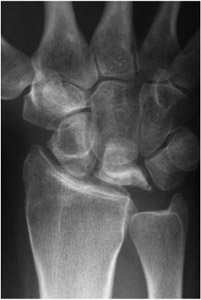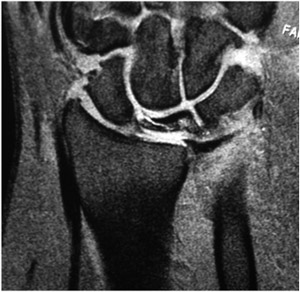What is Kienbock's Disease?
In Kienbock's disease the lunate bone, which is one of the small bones in the wrist, dies (osteonecrosis) and collapses. The cause of this rare condition in unknown but it is thought that it occurs as a consequence of disruption in the blood supply to the lunate bone. Trauma is not generally considered to cause the condition.
Symptoms:
Wrist pain: This is usually how the condition presents. The pain can vary in severity and may be mild.
Wrist swelling: Usually mild.
Diagnosis:
X-rays: These show characteristic changes.
- increased density of the lunate bone (sclerosis)
- collapse of the lunate bone
- a long radius bone (ulnar plus deformity) in many patients

Figure 1: Wrist x-ray showing collapse of the lunate bone and an ulnar plus deformity
In the early stages of the condition, x-rays can be normal. An MRI scan is useful as this can show an alteration in the blood supply to the lunate bone. which is characteristic of the condition.

Figure 2: MRI scan of Kienbock's disease showing the lunate collapse.
Treatment:
In cases where there is no wrist arthritis, the surgical treatment consists of restoring a blood supply to the lunate bone and reducing the pressure on the bone. A new blood supply is restored by redirecting and implanting a small artery into the lunate. If there is an ulnar plus deformity, the radius bone can also be shortened (a radial shortening osteotomy)